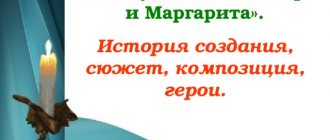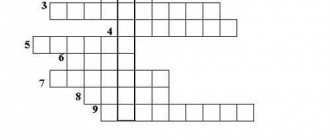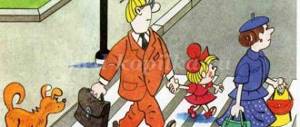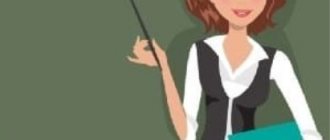Quiz based on M. Bulgakov’s novel “The Master and Margarita” literature test (grade 11) on the topic
Quiz based on the novel by M. Bulgakov “The Master and Margarita”
1. From which work is the epigraph to the novel taken? (I.V. Goethe “Faust”)
2. What was Woland’s appearance? (Tall, platinum crowns on the left side, gold crowns on the left. In an expensive gray suit, shoes matching the color of the suit, a gray beret. Crooked mouth. Shaven smooth. Brunette. Right eye black, left eye green, black eyebrows, but one higher than the other. A cane with a black knob in the shape of a poodle's head.)
3. What was Woland’s age at first glance? (40 plus)
4. How many proofs of the life of God does Woland talk about? (About five)
5. Which professor does Woland mention, calling him Immanuel? (Kant)
6. How does M. Bulgakov describe Woland’s cigarette case? (Huge in size, scarlet gold, and on the lid a diamond triangle sparkled with blue fire.)
7. What illness did Pontius Pilate suffer from? (hemicrania)
8. How old was Yeshua? (27) Why not 33, like Christ? Was M. Bulgakov wrong?
9. What is the main issue on which the dispute between Pontius Pilate and Yeshua took place? By the way, a famous painting by a Russian artist has the same name. (What is truth?)
10. Under what pseudonym did Nastasya Lukinichna Nepremenova write sea stories? (Navigator Georges)
11. Who were the victims of apartment No. 50 before the events described? (Widow of the jeweler de Fougere Anna Frantsevna, tenant with a lost surname, Belomut, Madame Belomur, Anfisa.)
12. Why didn’t Ivan Bezdomny write a statement to the police?
13. How was money verified in the variety show? (Looks like watermarks, smells them)
14. What spoiled Muscovites? (Housing problem)
15. How long before the day of the incident was the novel written by the master?
(In a year)
16. What was the master’s last name? Why?
17. How many languages did the master know? (Five)
18. What flowers did Margarita carry in her hands? (Yellow ones, most likely mimosas)
19. What stages did the master go through? (1/ laughter; 2/ surprise; 3/ fear.)
20. How fresh was Andrei Fokich’s sturgeon? (Second)
21. How much savings did the bartender have? (249 thousand in savings banks, 200 gold tens)
22. On what mountain did Yeshua’s execution take place? (On Bald Mountain.) What is the name of this mountain in mythology? (Calvary)
23. How old was Margarita? (30) How old was she when she got married? (19)
24. On what day of the week did Margarita become a witch? (On Friday)
25. In what dimension does the evil spirit live in M. Bulgakov? (Fifth)
26. What conditions had to be met in order to choose the hostess of the ball? (It is obligatory to bear the name Margarita and must be a local native).
27. Who was the conductor at the ball? (Johann Strauss)
28. What did Hippopotamus eat on the festive night? (I salted and peppered a piece of pineapple, ate it, and then drank a glass of alcohol.)
29. What can you say about the origin of Pontius Pilate? (The son of the astrologer king and the miller’s daughter, the beautiful Pyla.)
30. How did the master finish the novel? (“Free! Free! He’s waiting for you!”
31. On what day do the events in the novel take place? (On Sunday)
32. Who do Fagot-Koroviev and Behemoth turn into? (Fagot-Koroviev - into a dark purple knight with the gloomiest and never smiling face; Behemoth - into a demon page.)
33. How much time has passed since the beginning of the torment of Pontius Pilate? (About two thousand years.)
Lesson-quiz based on the novel by M.A. Bulgakov “The Master and Margarita”. Grade 11.
Lesson-quiz based on the novel by M.A. Bulgakov “The Master and Margarita”. Grade 11.
Target:
summarize the material after studying the work:
– factual background of the novel
— the problems of the novel
- ideological and artistic originality
-characteristics of the figurative system
Participants: two teams of 6 people, choose a name.
Mandatory condition: respondents in competitions should not be repeated.
Equipment: multimedia projector, computer, two presentations “M. Bulgakov”, “Game based on M. Bulgakov’s novel “The Master and Margarita”, film fragment of Bortko’s film
(Presentation “M. Bulgakov”)
Teacher's word (
against the backdrop of changing slides")
(Reading an excerpt from the novel)
“What is the novel about?” Woland asked.
-Novel about Pontius Pilate.
Here the flames jumped again, the dishes rattled, Woland laughed thunderously, but did not frighten anyone. ...
-About what, about what? About whom?” Woland spoke, stopping laughing. - Now? It's amazing! And you couldn’t find another topic?”
Indeed, HE could not find another topic!
What is Mikhail Afanasyevich Bulgakov’s Sunset Novel about?
THE WORLD IS MAN IS TRUTH, but behind this apparent simplicity, in his novel-testament, in the novel of despair and hope, in his “Gospel” Bulgakov raises deep moral and philosophical questions. Behind the diversity of phantasmagoric and satirical scenes, buffoonery and irony, behind the realities of everyday life in the early 30s of the 20th century, universal human problems are clearly visible.
A WORLD in which there is an eternal struggle between the forces of creation and decay, which have chosen the minds and souls of people as the battlefield.
And the TRUTH, eternal and everlasting for everyone and always!
Woland and his company help people from different eras meet and understand each other and themselves. And Mikhail Afanasyevich’s novel helps us look into ourselves.
So, “Follow me, my reader!” Let’s look through the “book for all times” of the immortal great Master once again, because “manuscripts don’t burn!”
1. Competition “It’s time! It's time!
Knowledge of the novel's facts.
Presentation "Game based on the novel"
Questions (highlighted in the presentation) in order for each participant.
1 “order” for correct answers. If there is no answer, then the turn goes to the opponent.
- Name the famous place in Moscow where the action begins in M. Bulgakov’s novel? (Patriarch's Ponds).
- What did the audience demand at the Variety show and ultimately get? (Revelations).
- As you know, Muscovites have been spoiled by the “housing problem.” Who applied for the Master's living space? (Aloisy Mogarych).
- Tell me the exact address of the place where the famous ball at Satan's took place. (Sadovaya street, building No. 302 bis, apt. 50)
- What was the name of the famous conductor at Woland's ball? (Strauss)
- Why was Pontius Pilate punished? (for cowardice)
- What was Banga, the dog of the procurator Pontius Pilate, afraid of? (thunderstorms)
- A souvenir given by Woland to Margarita and “privatized” by the unforgettable “plague” Annushka? (Golden horseshoe with diamonds).
- What type of clothing are cats not supposed to wear? ( Trousers)
- Ivan Bezdomny's real name? (Ponyrev)
- What does Ivan Bezdomny lose after swimming in the Moscow River? (MASSOLITA membership card).
- The last word with which Judas of Kiriath dies? (Niza..).
2.Competition "Extracting.. truth""
Questions that help determine the ideological and artistic originality of the novel
For
“Tests ” 1 person at a time, sit at tables, questions are written, circle the correct answer.
The team solves a “problematic issue ”: during the draw, the team gets 1 question for discussion (3 minutes), then one representative from the team answers. Questions are highlighted in the Presentation.
After passing the tests, discuss problematic issues.
Problematic issues.
1. One of the researchers of Bulgakov’s novel believes that the structural core of the “ancient” chapters is the theme of Pilate’s guilt, “Pilate’s sin.” The decision to put Yeshua to death leads Pilate to a “terrible” discord, an internal conflict. What is this discord and what is one of the novel's problems associated with it?
2. How is Woland Fried different from other guests? Why exactly is she forgiven, what is her “similarity” with Pilate, and what are the problems of the novel associated with her image?
Evaluation: 5 “orders” each.
3.Tests.
They allow you to assess the depth of comprehension of the work. Each question contains three answers, assessed by a certain number of points: (0) - incorrect answer or very primitive;
(1) - a formally correct answer, but incomplete or not containing the necessary depth of understanding of the text;
(2) - the correct answer, characterized by depth and accuracy.
The Secretariat checks the correctness of the answers and issues the appropriate number of “orders”.
1.What do you see as the main problems of the novel?
A) in the problem of human choice and moral responsibility (2)
B) in the problem of the relationship between good and evil (1)
B) in the problem of life and death (0)
2.What is the meaning of the epigraph?
A) Good and evil are inseparable: both serve justice (2)
B) Don’t do good to people - you won’t get evil (0)
C) The epigraph expresses the internal inconsistency of the “prince of darkness” (1)
3) Why are “Yershalaim chapters” needed in the novel?
A) These are chapters of a novel written by the Master (0)
B) To show what good is (1)
C) To show how true goodness can turn an evil person into a good one (2)
4) How are the “Moscow” and “Yershalaim” chapters connected?
A) The chapters are contrastingly opposed (0)
B) Both chapters have the same moral laws (2)
C) are connected by the figure of the Master as the author of the novel about Pontius Pilate (1)
5) What are the functions of Woland’s “department”?
A) Absolution (0)
B) Holds court on people (1)
C) Conducts an “audit” of human souls, exposing evil and vices (2)
4. “In collaboration with the Master”
“In collaboration with the Master”: a text with missing words is distributed, it is necessary to restore it.. Evaluation by the secretariat: “order” for each word. (See text below).
While this work is being completed, the next competition is being held.
5. “And you look inside him, what he thinks there... you will gasp!”
“Creating a literary image ”: a literary character and the means of creating it.
Each team has two representatives who recognize literary heroes from their verbal portraits. Then a “literary interview” is conducted with them.
Portraits and questions for the characters are displayed in the Presentation.
"Know yourself"
Woland:
“The mouth is kind of crooked. Shaven clean. Brunette. The right eye is black, the left one is green for some reason. The eyebrows are black, but one is higher than the other."
Master:
“...shaven, dark-haired, with a sharp nose, anxious eyes and a tuft of hair hanging over his forehead...”
Margarita:
“The eyebrows, plucked at the edges into a thread with tweezers, thickened and lay in black, even arches above the green eyes. The thin vertical wrinkle that cut the bridge of the nose... disappeared without a trace. The skin of the cheeks became pink, the forehead became white and clean, and the hairdresser’s curl developed.”
Yeshua Ha-Nozri:
“This man was dressed in an old and torn blue chiton. His head was covered with a white bandage with a strap around his forehead, and his hands were tied behind his back.”
Each hero chooses his own attribute item.
(Items: a cane with a poodle head, a hat with the letter M,
(“an old brown leather album with a photograph of the master, a savings book for 10,000 rubles, dried rose petals and part of a notebook full of paper, written on a typewriter and with a burnt bottom edge” - this is the only valuable thing that Margarita had in her life), a hair ), wrapped in paper (“From a conversation with P.P.: Pilate calls on Yeshua to swear that he did not call for the destruction of the temple.
And: -What do you want to swear by?
P.P.: -Well, at least your life, since it hangs by
a thread!
I.: - Don’t you think that you hung her up, hegemon? If so, you are very mistaken.
P.P.: -I can cut this hair.
I.: -And you are mistaken in this, agree that only the one who hung it can probably cut the hair?
6. Competition “Why an icon?”
(“The World of Literary Things”)
Two tables with covered items. One member per team. Their task is to remember where in the novel a given subject is found and how it is related to the content) Assessment: according to the “order” for two subjects, the maximum number is -3. Possible decoy items.
1 table:
1. Chess (Woland played with them, the figures are alive)
2.Handkerchief with a blue border (served to Frida)
3. Cut paper (the money that was used to pay at the variety show buffet after the show was turned into it, the bartender Andrei Fokich talks about this in a conversation with Woland, there is also a conversation about sturgeon of the second freshness).
4.Candle, icon, pin (attributes of Ivan Bezdomny, underpants are missing).
5. Centimeter (he “dangled” on the neck of Hippopotamus in Variety)
6. Tights (fake, they were stockings)
Table 2:
1. Floor brush (Margarita flew on it)
2.Globe (symbol of Woland’s power)
3. A case with a bottle of perfume (it is given to the brave lady (as a present from the company, according to Fagot), who was the first to decide to dress up in a ladies' store).
4. Pickled chicken bone (Koroviev’s attribute)
5. Poison (“I’m poisoned, poisoned!” - the thoughts of the Procurator when he had a headache)
6. Lotto (trick, there was chess)
Summarizing.
Additionally: display of materials from homework: Booklets on the novel, “business cards” of the characters.
Final words from the teacher:
Good and evil, faith and unbelief, immortality, eternity, mercy, forgiveness, compassion, choice and personal responsibility for it.
This is Bulgakov, this is real literature.
Bulgakov checked the present with the past. So let's use this book to test the value of what we read today.
7



